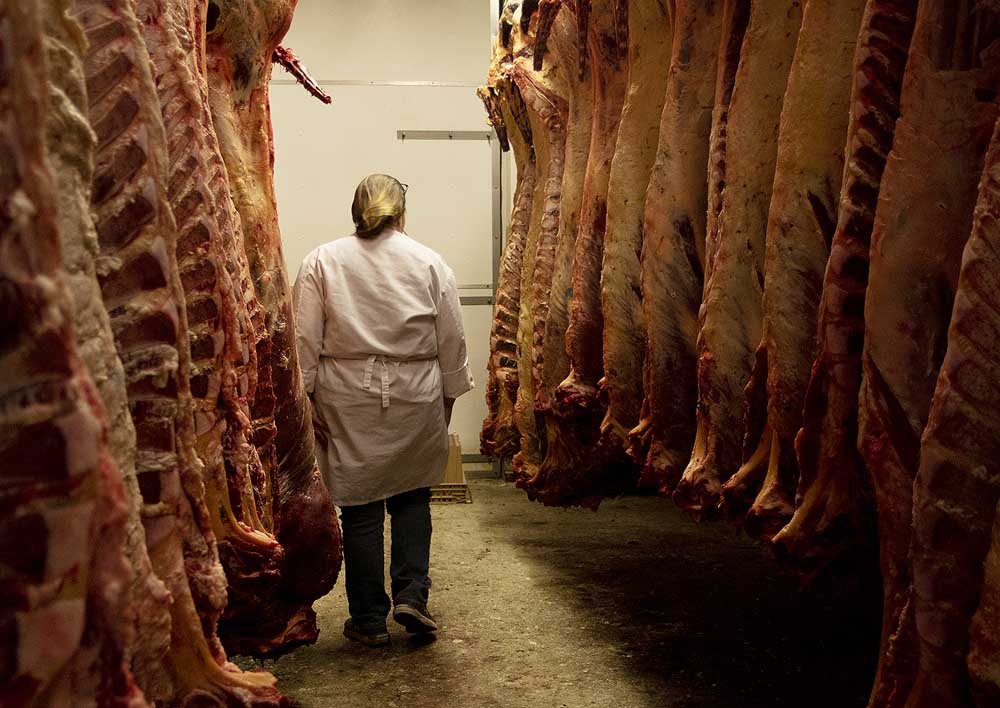Meat plant startups face barriers. What are the solutions?
Published 12:45 pm Tuesday, November 2, 2021

- Denise Pohrman, plant manager at Mohawk Valley Meats in Eugene, Ore., walks through rows of carcasses.
It’s no secret that four companies — Cargill, Tyson Foods, JBS and National Beef Packing Co. — slaughter about 85% of U.S. grain-fattened cattle, and many ranchers aren’t happy about it.
In response, USDA this year is offering millions of dollars in grants and loans to meat plants and startups.
But starting a butchering operation is no cakewalk, and many proposed operations have failed or been delayed. The Capital Press talked with several experts about barriers to starting a meat plant — and possible solutions.
Labor
Rebecca Thistlethwaite, director of the Niche Meat Processor Assistance Network, said she thinks the No. 1 obstacle is labor.
A plant doing full portion cuts needs about one employee for every animal harvested per day, said Thistlethwaite. That means a plant processing 200 head per day needs about 200 workers.
Experts say meat plants should consider investing in automation. Revel Meat Co. in Canby, Ore., for example, added a machine that vacuum-seals meats, saving on labor.
Capital
Thistlethwaite said the No. 2 challenge is access to capital. People are excited about money from USDA, she said, but many who want to start a plant don’t have sufficient capital and investor backing.
Volume
The third barrier to processors’ success, said Thistlethwaite, is not having consistent volume. She recalled how Livestock Producers Cooperative Association, a plant in Odessa, Wash., failed because its leaders miscalculated the regional volume of slaughter-ready animals. There were plenty of cow-calf producers in the area, but not enough ranches with finished animals. It has since reopened under a new name and new ownership.
Industry economists recommend startups go where there are processing gaps, minimal competition, sufficient volume of slaughter-ready animals and established brands.
Siting and odor
Finding the right site is another challenge, said Jacek Koziel, air quality and livestock odor expert at Iowa State University. Project leaders must have detailed waste plans, ensure a site has adequate water and pick a location remote enough to be out of the way yet close enough to be a reasonable commute for workers.
Koziel said it’s also crucial for new plants to do predictive modeling on local weather and prevailing winds to predict who downwind will be affected by odors and then install odor control technologies.
Bob Delmore, meat science professor at Colorado State University, said a plant should also have a backup plan, like adequate cooler space, for when something goes wrong at the rendering facility and there’s a backlog of animal parts post-slaughter.
“It’s not a matter of if, but when,” said Delmore.
Community
One of the biggest challenges with starting a meat plant is disagreement among stakeholders, including local farmers, businesses, agencies, environmental groups and community members.
Americans want more small meat plants — just not next door.
Kathie Taylor, a spokeswoman who represents Carson Valley Meats, a proposed slaughterhouse in Nevada, told the Capital Press in an email the project’s leader for the past three years has faced pushback from local residents.
“The NIMBY (Not In My Backyard) hysteria is real,” Taylor wrote.
Koziel of Iowa State University said he encourages startup leaders to include major stakeholders in conversations early on to prevent bigger conflicts later.
Experience
Industry leaders say because of the COVID-related spike in meat prices, government financing and renewed interest in regional food, droves of people are rushing to start meat plants this year, but many aren’t qualified. Several experts said they’ve received inquiries about how to start a plant from people with zero slaughtering, processing or even business experience.
Experts say startup leaders need a team of experienced professionals, must comply with regulatory standards and should recognize that the current market with its high meat prices and year-round processing opportunities won’t last.
Thistlethwaite of the meat association said that while she’s grateful USDA is investing in new plants, she has higher hopes for the agency’s investments in existing plants.
“Startups are just notoriously — they don’t always have a good success rate,” she said. “Just adding new processors does not necessarily solve ranchers’ problems. It often makes more sense to expand existing processors.”
The Niche Meat Processor Assistance Network created a guide to help startups avoid common pitfalls. Click here to read the guide, called “So You Want to Start a Meat Plant?”






